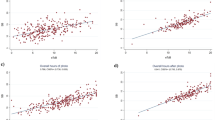Abstract
Neonatal blue light phototherapy (NBLP) is an effective treatment for hyperbilirubinaemia. Concerning the influence on melanocytic nevi, conflicting studies have been published. To assess the role of NBLP according to the incidence of melanocytic nevi in preschool children, a cohort of 104 5- to 6-year-old children were included. The case group consisted of 52 NBLP-exposed children, while the control group (n = 52) never had NBLP and was matched regarding age, gender, gestational age and skin phototype. Six dizygotic twins were included with one twin having received NBLP, respectively. The following parameters were recorded: nevi count, presence of freckles, café-au-lait macules, skin phototype and previous history of sun exposure. There was no significant association between nevi count and exposure to NBLP (median nevi count 17.0 compared to 18.5 in controls). No significant difference was also found in the dizygotic twin pairs with a median nevi count of 10.0 (with NBLP) compared to 14.5 (without NBLP). However, a significantly higher prevalence of café-au-lait macules was found in children with NBLP (mean count 0.5) than in children without NBLP (mean count 0.2; p = 0.001). Significant predictors for the number of melanocytic nevi included skin phototype, sun exposure and vacations in the South. Conclusion: In this study, NBLP had no significant influence on the development of melanocytic nevi, but on café-au-lait macules which was a new finding. Differences with comparable studies regarding age, differentiation between nevi and other pigmented lesions as well as dose and type of NBLP need to be taken into account for further investigations.

Similar content being viewed by others
Abbreviations
- CAMN:
-
Clinically atypical melanocytic nevi
- CMN:
-
Common melanocytic nevi
- LMU:
-
Ludwig-Maximilian University
- MN:
-
Melanocytic nevi
- NBLP:
-
Neonatal blue light phototherapy
- No.:
-
Number
- p :
-
p value
- χ 2 :
-
Chi-square test
References
Amer M, Mostafa FF, Nasr AN (2001) Lentiginous macules and patches of neurofibromatosis (an approach to better terminology). J Eur Acad Dermatol Venereol 15:39–42
American Academy of Pediatrics, Subcommittee on Hyperbilirubinemia (2004) Management of hyperbilirubinemia in the newborn infant 35 or more weeks of gestation. Pediatrics 114:297–316
Bauer J, Buttner P, Luther H, Wiecker TS, Mohrle M, Garbe C (2004) Blue light phototherapy of neonatal jaundice does not increase the risk for melanocytic nevi development. Arch Dermatol 140:493–494
Bauer J, Buttner P, Wiecker TS, Luther H, Garbe C (2005) Risk factors of incident melanocytic nevi: a longitudinal study in a cohort of 1,232 young German children. Int J Cancer 115:121–126
Brewster DH, Tucker JS, Fleming M, Morris C, Stockton DL, Lloyd DJ, Bhattacharya S, Chalmers JW (2010) Risk of skin cancer after neonatal phototherapy: retrospective cohort study. Arch Dis Child 95:826–831
Cremer RJ, Perryman PW, Richards DH (1958) Influence of light on the hyperbilirubinaemia of infants. Lancet 1:1094–1097
Csoma Z, Hencz P, Orvos H, Kemeny L, Dobozy A, Dosa-Racz E, Erdei Z, Bartusek D, Olah J (2007) Neonatal blue-light phototherapy could increase the risk of dysplastic nevi development. Pediatrics 119:1036–1037, author reply 1037-1038
Csoma Z, Kemeny L, Olah J (2008) Phototherapy for neonatal jaundice. N Engl J Med 358:2523–2524, author reply 2524-2525
Csoma Z, Toth-Molnar E, Balogh K, Polyanka H, Orvos H, Ocsai H, Kemeny L, Szell M, Olah J (2011) Neonatal blue light phototherapy and melanocytic nevi: a twin study. Pediatrics 128:e856–e864
Darlington S, Siskind V, Green L, Green A (2002) Longitudinal study of melanocytic nevi in adolescents. J Am Acad Dermatol 46:715–722
Dennery PA, Seidman DS, Stevenson DK (2001) Neonatal hyperbilirubinemia. N Engl J Med 344:581–590
Dulon M, Weichenthal M, Blettner M, Breitbart M, Hetzer M, Greinert R, Baumgardt-Elms C, Breitbart EW (2002) Sun exposure and number of nevi in 5- to 6-year-old European children. J Clin Epidemiol 55:1075–1081
Fitzpatrick TB (1988) The validity and practicality of sun-reactive skin types I through VI. Arch Dermatol 124:869–871
Gandini S, Sera F, Cattaruzza MS, Pasquini P, Abeni D, Boyle P, Melchi CF (2005) Meta-analysis of risk factors for cutaneous melanoma: I. Common and atypical naevi. Eur J Cancer 41:28–44
Harrison SL, MacLennan R, Buettner PG (2008) Sun exposure and the incidence of melanocytic nevi in young Australian children. Cancer Epidemiol Biomarkers Prev 17:2318–2324
International Electrotechnical Commission (2010) International standard: medical electrical equipment part 2-50-particular requirements for the safety of infant phototherapy equipment 60601-2-50, ed2.0. (2009-03-24). http://webstore.iec.ch/webstore/webstore.ndf/Artnum_PK/42737. Accessed December 2011
Mahé E, Beauchet A, Aegerter P, Saiag P (2009) Neonatal blue-light phototherapy does not increase nevi count in 9-year-old children. Pediatrics 123:e896–e900
Maisels MJ, Newman TB (2007) Neonatal blue-light phototherapy could increase the risk of dysplastic nevus development. Pediatrics 119:1037
Matichard E, Le Henanff A, Sanders A, Leguyadec J, Crickx B, Descamps V (2006) Effect of neonatal phototherapy on melanocytic nevi count in children. Arch Dermatol 142:1599–1604
Rodvall Y, Wahlgren CF, Ullen H, Wiklund K (2007) Common melanocytic nevi in 7-year-old schoolchildren residing at different latitudes in Sweden. Cancer Epidemiol Biomarkers Prev 16:122–127
Valiukeviciene S, Miseviciene I, Gollnick H (2005) The prevalence of common acquired melanocytic nevi and the relationship with skin type characteristics and sun exposure among children in Lithuania. Arch Dermatol 141:579–586
Wiecker TS, Luther H, Buettner P, Bauer J, Garbe C (2003) Moderate sun exposure and nevi counts in parents are associated with development of melanocytic nevi in childhood: a risk factor study in 1,812 kindergarten children. Cancer 97:628–638
Acknowledgments
We especially thank all infants and their parents for participating in this study at the Department of Dermatology at the Ludwig-Maximilian University of Munich.
Conflict of interest
The authors have no conflict of interest to declare.
Author information
Authors and Affiliations
Corresponding author
Additional information
Communicated by Patrick Van Reempts
Rights and permissions
About this article
Cite this article
Wintermeier, K., von Poblotzki, M., Genzel-Boroviczény, O. et al. Neonatal blue light phototherapy increases café-au-lait macules in preschool children. Eur J Pediatr 173, 1519–1525 (2014). https://doi.org/10.1007/s00431-014-2349-8
Received:
Revised:
Accepted:
Published:
Issue Date:
DOI: https://doi.org/10.1007/s00431-014-2349-8




